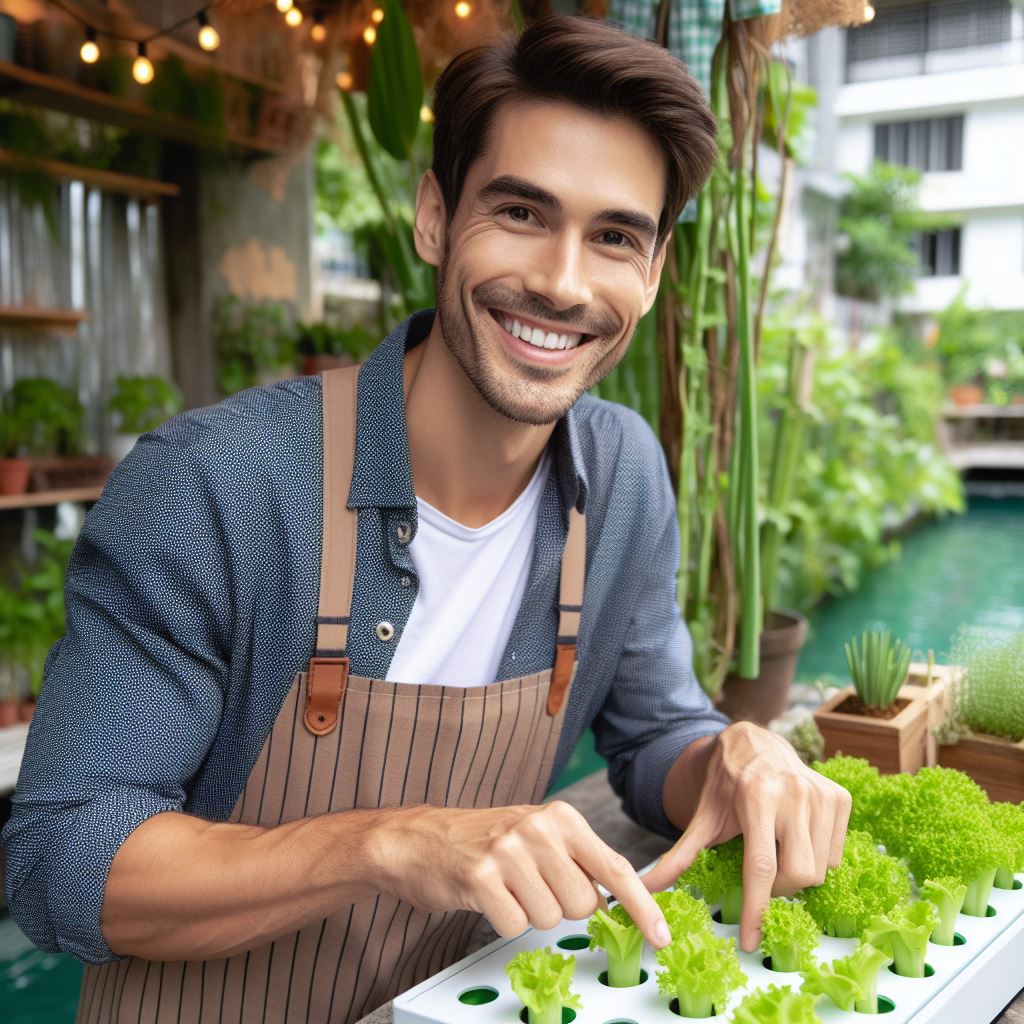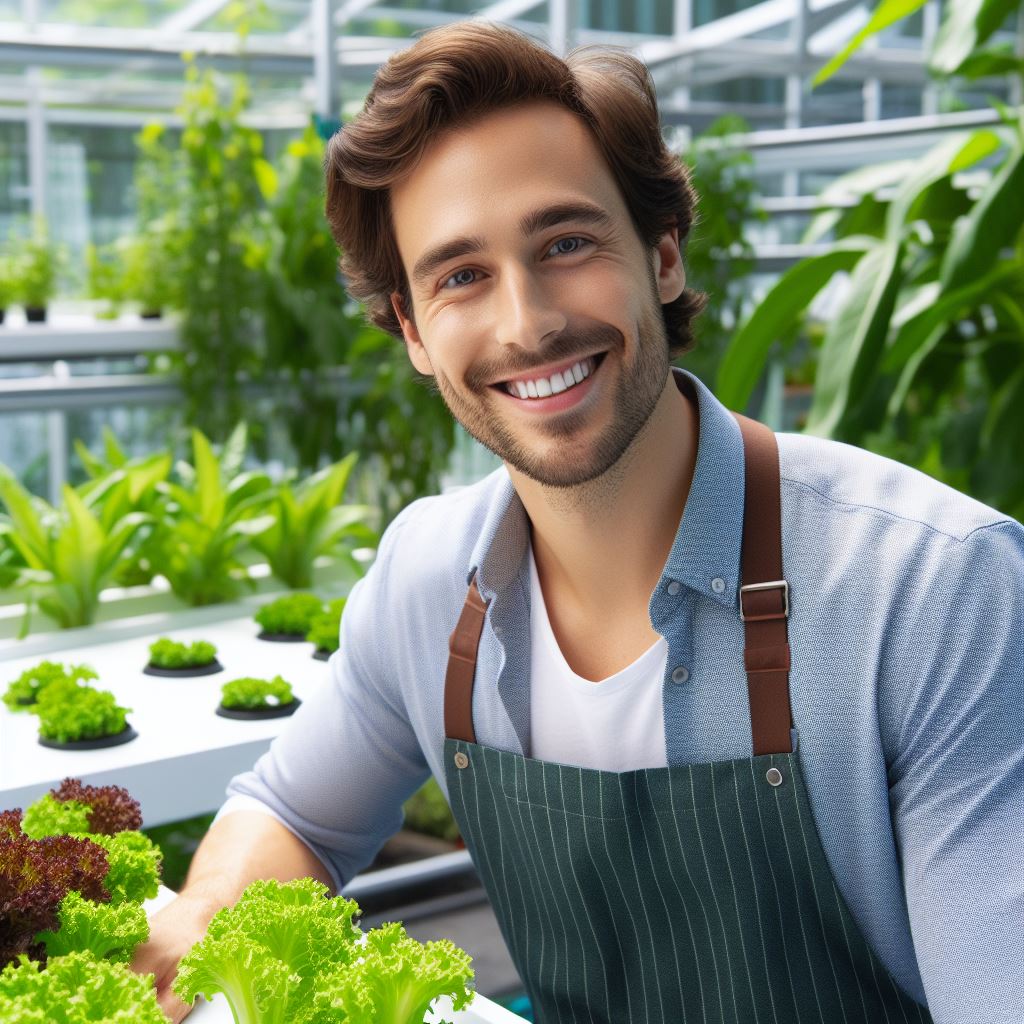Introduction
Urban gardening plays a crucial role in providing access to fresh and nutritious food to urban dwellers.
The concept of aquaponic gardening combines fish farming and plant cultivation, offering numerous benefits.
Aquaponic gardening promotes sustainable food production, reduces water usage, and eliminates the need for synthetic fertilizers.
With the increasing popularity of urban farming, aquaponic gardening provides a viable solution for limited space availability.
This innovative gardening method enables individuals to grow their own food, even in small apartments or urban areas.
By utilizing the waste produced by fish, aquaponic gardens create a symbiotic relationship between plants and aquatic animals.
The plants in the system naturally filter the water and remove harmful toxins, creating a healthy environment for the fish.
Aquaponic gardening is a cost-effective and eco-friendly method that produces both fish and vegetables year-round.
This gardening technique offers a year-round growing season, maximizing the productivity of limited urban spaces.
In addition to producing fresh and organic produce, aquaponic gardens serve as a decorative element in urban landscapes.
The integration of fish and plants in aquaponic systems creates a harmonious and visually appealing oasis in urban environments.
Basically, aquaponic gardening combines sustainability, efficiency, and aesthetic appeal to provide an urban oasis for fresh and nutritious food production.
What is Aquaponic Gardening?
Explanation of aquaponics
Aquaponic gardening is a unique method of cultivation that combines aquaculture (the breeding of fish) and hydroponics (growing plants in water).
It works by creating a closed-loop system, where fish waste provides nutrients for the plants, and the plants act as a natural filter, purifying the water for the fish.
Components of an aquaponic system
An aquaponic system consists of four main components that work together to create a thriving ecosystem:
Fish tank
The fish tank is the heart of the aquaponic system. It houses the fish, which produce waste in the form of ammonia.
This waste is then converted by beneficial bacteria into nitrites and nitrates, which are essential nutrients for plant growth.
Transform Your Agribusiness
Unlock your farm's potential with expert advice tailored to your needs. Get actionable steps that drive real results.
Get StartedGrow bed
The grow bed is where the plants are placed.
The grow bed is filled with a growing medium that provides support for the plants’ roots and helps distribute water evenly.
The plants take up the nutrients from the water, effectively cleaning it for the fish.
Water pump
A water pump is used to circulate water between the fish tank and the grow bed.
The pump ensures a constant flow of water, allowing the nutrients from the fish waste to be distributed to the plants.
This continuous circulation also prevents water stagnation and oxygenates the system.
To ensure the proper functioning of an aquaponic system, a well-designed plumbing system is crucial.
The plumbing system connects the fish tank, grow bed, and water pump, facilitating the flow of water.
It includes pipes, valves, and other fittings to control the water movement and maintain the desired water level in each component.
Aquaponic gardening offers numerous benefits, including efficient resource utilization, minimal water wastage, and organic plant cultivation.
It allows individuals to grow their own food in limited spaces, such as urban areas, while also promoting sustainable practices.
In essence, aquaponic gardening is a method that combines fish rearing and plant cultivation in a symbiotic environment.
Understanding the components of an aquaponic system is essential for setting up and maintaining a successful urban oasis.
How Does Aquaponic Gardening Work?
Aquaponic gardening is a fascinating and sustainable method of growing plants and raising fish in a mutually beneficial system.
Understanding how this system works is essential for successful implementation.
The nitrogen cycle in aquaponics
The nitrogen cycle is a crucial component of aquaponics.
Fish waste releases ammonia into the water, which is converted by nitrifying bacteria into nitrites, and then further converted into nitrates, which serve as nutrients for the plants.
In this way, fish waste is recycled into a natural fertilizer for the plants.
Symbiotic relationship between fish and plants
The symbiotic relationship between fish and plants is another important aspect of aquaponics.
Fish provide the necessary nutrients for plant growth through their waste, eliminating the need for chemical fertilizers.
In return, plants filter and cleanse the water, creating a healthy environment for the fish.
This mutual dependence ensures the health and productivity of both the fish and plants.
Role of bacteria in the system
Bacteria play a critical role in the aquaponic system.
Nitrifying bacteria, which live on the surfaces of the media beds and grow beds, are responsible for converting toxic ammonia into less harmful substances.
These bacteria provide the necessary biological filtration to maintain water quality and ensure the well-being of the fish and plants.
Without bacteria, the nitrogen cycle would not occur, disrupting the equilibrium of the system.
Implementing and maintaining a successful aquaponic garden requires careful monitoring of the nitrogen cycle and the health of both the fish and plants.
Regular water testing and adjustments may be needed to maintain proper nutrient levels.
Additionally, ensuring the right balance of fish to plants is vital to avoid overloading the system and causing stress on the fish.
In general, aquaponic gardening relies on the nitrogen cycle, symbiotic relationships, and the vital role of bacteria to create a sustainable and efficient system.
Understanding these principles is crucial for anyone interested in creating their own urban oasis and experiencing the benefits of aquaponics.
Read: Urban Farming: Small Plot, Big Yield
Setting Up an Aquaponic Garden
Choosing the right location
- Look for a sunny spot – Aquaponic gardens thrive with at least six to eight hours of direct sunlight daily.
- Ensure a stable temperature – Select a location that maintains a constant temperature between 70°F and 86°F.
- Consider accessibility – Choose a spot that is easily accessible for maintenance and harvesting.
Selecting the appropriate fish and plants
- Research suitable fish species – Opt for fish like tilapia, trout, or catfish that are resilient and adaptable to aquaponic systems.
- Determine plant compatibility – Choose plants that can thrive in a hydroponic environment, such as lettuce, herbs, or tomatoes.
- Ensure balanced nutrient requirements – Select fish and plants that have similar nutrient requirements for a harmonious ecosystem.
Assembling the necessary equipment
- Fish tank – Choose a large enough tank to accommodate the desired number and size of fish.
- Grow beds – Select grow beds that are spacious enough to support the growth of plants and have good drainage.
- Water pump – Install a reliable water pump to circulate water between the fish tank and grow beds.
- Aeration system – Incorporate an aeration system to ensure adequate oxygen levels for the fish.
- Grow medium – Use a suitable grow medium, such as expanded clay pellets or gravel, to support plant growth.
Building the aquaponic system step-by-step
- Set up the fish tank – Place the fish tank on a sturdy stand and fill it with water.
- Install the grow beds – Position the grow beds above the fish tank, allowing water to flow from one to the other.
- Connect the water pump – Attach the water pump to create a continuous flow of water between the fish tank and grow beds.
- Add the aeration system – Install the aeration system in the fish tank to ensure optimum oxygen levels for the fish.
- Introduce the fish – Gradually introduce the selected fish species into the tank and monitor their health.
- Plant the seeds or seedlings – Place the chosen plants in the grow beds using the selected grow medium.
- Monitor and adjust the system – Regularly check water quality, nutrient levels, and pH balance to maintain a healthy ecosystem.
- Harvest and enjoy – As the plants grow, harvest and enjoy the fresh produce while monitoring and caring for the fish.
By following these steps, you can set up your own urban oasis and enjoy the benefits of aquaponic gardening.
The self-sustaining nature of this system allows you to grow fresh, organic produce while also enjoying the calming presence of fish.
Start your aquaponic journey today and experience the wonders of this innovative gardening method.
Read: Balcony Veggie Gardens: Tips and Tricks
Benefits of Aquaponic Gardening
Water efficiency compared to traditional gardening
- Aquaponic gardening utilizes up to 90% less water than traditional soil-based gardening.
- The closed-loop system recirculates water between the fish tank and the grow beds, minimizing waste.
- Water is continually filtered and reused, significantly reducing the overall water consumption.
- Water efficient practices help conserve this precious resource, especially in water-scarce areas.
Organic and pesticide-free produce
- Aquaponic gardening eliminates the need for artificial fertilizers and harmful chemical pesticides.
- The nutrient-rich fish waste provides natural fertilization, promoting healthy plant growth.
- The absence of pesticides ensures the production of organic, chemical-free fruits, vegetables, and herbs.
- Consuming pesticide-free produce contributes to improved health and reduces the risk of chemical exposure.
Reduced reliance on outside resources
- Aquaponic gardening reduces the dependence on traditional agricultural inputs like soil and chemical fertilizers.
- The self-sustaining ecosystem creates a symbiotic relationship between fish, plants, and beneficial bacteria.
- It eliminates the need for extensive land use and minimizes the use of energy-intensive machinery.
- By relying on natural processes, aquaponic gardeners minimize their carbon footprint and environmental impact.
Potential for year-round gardening
- Aquaponic systems can be designed indoors or in greenhouses, extending the growing season throughout the year.
- The controlled environment allows for consistent temperature, lighting, and humidity, ensuring optimal plant growth.
- Year-round gardening provides a sustainable and reliable source of fresh produce regardless of seasonal limitations.
- Aquaponic gardeners can enjoy a continuous harvest, improving food security and self-sufficiency.
In review, aquaponic gardening offers a multitude of benefits compared to traditional gardening methods.
Its water efficiency drastically reduces water consumption, making it an environmentally friendly choice in areas with limited water resources.
The absence of pesticides and reliance on natural fertilization make aquaponic produce organic and free of harmful chemicals.
By creating a self-sustaining ecosystem, aquaponic gardeners minimize their reliance on outside resources and reduce their carbon footprint.
Additionally, the potential for year-round gardening in controlled environments ensures a steady supply of fresh produce, contributing to food security and self-sufficiency.
With these advantages, aquaponic gardening presents a promising solution for sustainable urban agriculture.
Read: City Herbs: Growing Flavor in Tiny Spaces

Maintenance Tips for Aquaponic Gardens
Monitoring water quality
- Regularly test the pH, ammonia, nitrate, and temperature levels of the water.
- Maintain optimal water conditions for healthy fish and plant growth.
- Monitor the dissolved oxygen levels to ensure proper oxygenation for both fish and plants.
- Keep a record of water quality data for future reference and troubleshooting.
Feeding and caring for fish
- Provide appropriate feed for the fish species in your aquaponic system.
- Monitor feeding habits and adjust the amount of food accordingly.
- Remove any uneaten food to prevent water contamination.
- Regularly check fish health and behavior for signs of stress or illness.
- Ensure proper filtration and aeration to maintain a clean and healthy environment for fish.
Pruning and harvesting plants
- Regularly inspect plants for any signs of pests, diseases, or nutrient deficiencies.
- Remove any damaged or diseased plant parts to prevent the spread of infections.
- Harvest mature and ripe plants as needed, maintaining a balance between growth and consumption.
- Prune plants to promote bushier growth and prevent overcrowding in the aquaponic system.
Preventing and treating common issues
- Keep an eye out for common issues such as nutrient imbalances, plant nutrient deficiencies, or algae growth.
- Address nutrient imbalances by adjusting the fish feed or adding appropriate supplements.
- Supplement with additional nutrients, like iron or potassium, if plants show signs of deficiencies.
- Implement preventive measures, such as adequate system cleaning and maintaining proper water circulation, to avoid algae growth.
- Research and consult with experienced aquaponic gardeners to troubleshoot and address any specific issues.
Regular maintenance is essential to ensuring the success of your aquaponic garden.
By closely monitoring water quality, feeding and caring for the fish, pruning and harvesting plants, and preventing/treating common issues, you can create a thriving urban oasis right in your own home.
Read: Watering Tips for Small Gardens & Farms
Learn More: Composting Myths Debunked: What Works
Troubleshooting Common Aquaponic Gardening Problems
Algae growth
Aquaponic gardens sometimes experience issues with excessive algae growth, which can be detrimental to the system.
- Reduce sunlight exposure to the water by shading the garden or using a pond cover.
- Avoid overfeeding the fish, as uneaten food can contribute to algae growth.
- Implement a proper balance between fish density and plant capacity to control nutrient levels.
- Regularly clean the filters and maintain a good water flow to prevent algae buildup.
pH fluctuations
Maintaining a stable pH level is crucial for the health and growth of both the fish and plants in an aquaponic system.
- Test the water regularly using a pH kit to monitor any fluctuations.
- If pH levels are too high, add an acid buffer like phosphoric acid.
- If pH levels are too low, add an alkaline buffer like potassium bicarbonate.
- Avoid sudden changes in pH by making gradual adjustments and monitoring the results.
Fish diseases
Keeping the fish in an aquaponic system healthy is key to a successful garden.
- Quarantine new fish before introducing them to the main system to prevent potential diseases.
- Provide a stress-free environment with proper water quality, temperature, and nutrition.
- Regularly inspect the fish for any signs of illness, such as abnormal behavior, loss of appetite, or visible symptoms.
- Treat any identified diseases promptly using appropriate medications or seeking professional advice.
Nutrient deficiencies
Plants in an aquaponic garden rely on the nutrients provided by the fish waste.
However, deficiencies may occur.
- Monitor the plant foliage for any signs of nutrient deficiencies, such as yellowing leaves or stunted growth.
- Conduct water tests to identify any nutrient imbalances or deficiencies.
- Adjust the fish feeding regimen to provide a sufficient amount of nutrients for the plants.
- Supplement with natural fertilizers or appropriate aquaponic-friendly nutrients, if needed.
In a nutshell, understanding and addressing common aquaponic gardening problems are essential for maintaining a thriving urban oasis.
By tackling issues such as algae growth, pH fluctuations, fish diseases, and nutrient deficiencies, gardeners can ensure the long-term success of their aquaponic systems.
Regular monitoring and prompt troubleshooting will lead to healthier fish, flourishing plants, and a sustainable urban garden.
Showcase Your Farming Business
Publish your professional farming services profile on our blog for a one-time fee of $200 and reach a dedicated audience of farmers and agribusiness owners.
Publish Your ProfileSuccess Stories and Case Studies
Profiles of successful aquaponic gardens in urban areas
- Garden City Oasis: Located in the heart of a bustling city, Garden City Oasis showcases the potential of aquaponic gardening.
- Sky High Greens: This rooftop aquaponic garden provides fresh produce to local restaurants, creating a sustainable food system.
- Urban Eden Farm: By utilizing aquaponics, Urban Eden Farm has transformed a vacant lot into a thriving urban oasis.
- City Green Life: With limited space, City Green Life utilizes vertical aquaponics to maximize their production and impact.
Lessons learned from real-world examples
- Start small: Many successful urban aquaponic gardens started with a small system and gradually expanded as they gained experience.
- Collaboration is key: Building partnerships with local businesses, schools, and community organizations can help in promoting and sustaining the garden.
- Continuous learning: Urban gardeners need to constantly educate themselves about aquaponics and adapt their techniques for maximum efficiency.
- Engage the community: Successful gardens actively involve the community through workshops, tours, and volunteer opportunities to create a sense of ownership.
Inspirational stories that highlight the potential of aquaponic gardening
- From Concrete Jungle to Green Haven: Witness the transformation of a neglected urban neighborhood into a thriving green space through aquaponics.
- Empowering Youth through Gardening: Read about how an aquaponic garden in a disadvantaged urban area provides a platform for youth education and empowerment.
- Raising Awareness on Sustainable Food Systems: Discover how an aquaponic garden in a busy city center raises awareness about the importance of sustainable farming.
- Feeding the Hungry: Explore the story of an urban aquaponic garden that contributes fresh produce to local food banks, addressing food insecurity in the community.
These success stories and case studies demonstrate the incredible potential of aquaponic gardening in urban areas.
They showcase the ability to transform vacant lots, rooftops, and underutilized spaces into green havens that provide fresh food, education, and community engagement.
By learning from real-world examples and implementing similar strategies, aspiring urban gardeners can create successful aquaponic gardens of their own.
The key lies in starting small, collaborating with others, continuously learning, and actively involving the community in the process.
Together, we can harness the potential of aquaponics to create sustainable, green oases in our concrete jungles.
Gain More Insights: Soil Health: Key for Seasonal Planting
Conclusion
Aquaponic gardening basics provide a sustainable and efficient solution for urban residents to grow their own food.
By combining aquaculture and hydroponics, aquaponics creates a symbiotic relationship between fish and plants.
Throughout this blog section, we have explored the various components and processes involved in aquaponic gardening.
From the fish tank to the grow bed, each element plays a crucial role in maintaining a healthy and thriving system.
While it may seem daunting at first, aquaponics offers numerous benefits, such as reduced water usage and organic food production.
This method eliminates the need for chemical fertilizers, creating a more sustainable and environmentally friendly way of gardening.
Moreover, aquaponic systems can be set up in any urban space, allowing individuals to transform their homes into green oases.
By cultivating plants and raising fish, urban dwellers can connect with nature and enhance the quality of their living environment.
As we look to the future, aquaponic gardening has the potential to revolutionize food production and sustainability in urban areas.
With increasing population density and limited access to green spaces, urban oasis is becoming a necessity.
So why not take the plunge and start your own aquaponic garden? It’s an opportunity to reconnect with nature, produce organic food, and contribute to a more sustainable future.
By embracing aquaponics, we can create a healthier and greener urban environment for generations to come.




